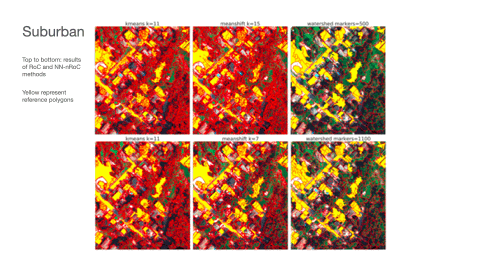Improving hyperspectral image segmentation by applying inverse noise weighting and outlier removal for optimal scale selection
Department of Geography, Geomatics and Environment
University of Toronto
3359 Mississauga Road, Mississauga ON L5L 1C6
Faculty of Science
University of Ontario Institute of Technology
2000 Simcoe St. N., Oshawa ON L1G 0C5
Abstract
Optimal scale selection for image segmentation is an essential component of the Object-Based Image Analysis (OBIA) and interpretation. An optimal segmentation scale is a scale at which image objects, overall, best rep- resent real-world ground objects and features across the entire image. At this scale, the intra-object variance is ideally lowest and the inter-object spatial autocorrelation is ideally highest, and a change in the scale could cause an abrupt change in these measures. Unsupervised parameter optimization methods typically use global measures of spatial and spectral properties calculated from all image objects in all bands as the target criteria to determine the optimal segmentation scale. However, no studies consider the effect of noise in image spectral bands on the segmentation assessment and scale selection. Furthermore, these global measures could be affected by outliers or extreme values from a small number of objects. These issues may lead to incorrect assessment and selection of optimal scales and cause the uncertainties in subsequent segmentation and classification results. These issues be- come more pronounced when segmenting hyperspectral data with large spectral variability across the spectrum. In this study, we propose an enhanced method that 1) incorporates the band’s inverse noise weighting in the seg- mentation and 2) detects and removes outliers before determining segmentation scale parameters. The proposed method is evaluated on three well-established segmentation approaches – k-means, mean-shift, and watershed. The generated segments are validated by comparing them with reference polygons using normalized over-seg- mentation (OS), under-segmentation (US), and the Euclidean Distance (ED) indices. The results demonstrate that this proposed scale selection method produces more accurate and reliable segmentation results. The approach can be applied to other segmentation selection criteria and are useful for automatic multi-parameter tuning and optimal scale parameter selections in OBIA methods in remote sensing.
Publication
For technical details please look at the following publications
